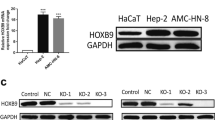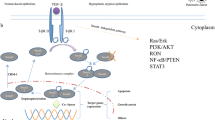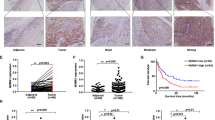Abstract
Our study explored the effects of SOST gene silencing on the proliferation, apoptosis, invasion, and migration of human osteosarcoma cells through Wnt/β-catenin signaling pathway. Fresh tissues were obtained from 108 patients with osteosarcoma and 46 patients with osteochondroma. Human osteosarcoma cells (MG-63, U2-OS, HOS, and Saos-2) and normal osteoblast (hFoB1.19) were selected and cultured. Osteosarcoma cells were grouped randomly into the blank group, the scrambled control group, and the SOST-siRNA group. Cell proliferation was determined by MTT assay. Cell cycle and apoptosis were tested by flow cytometry. Transwell and scratch test were performed to determine cell invasion and migration. The qRT-PCR and Western blotting were used to detect mRNA and protein expression level of sclerostin, Wnt1, β-catenin, C-Myc, Cyclin D1, and MMP-7. The activity of caspase-3 was assessed by immunocytochemistry. Alkaline phosphatase (ALP) activity was measured using P-nitrophenylphosphate as a substrate. Low SOST mRNA and sclerostin protein expression levels were observed in osteosarcoma tissues and cells. Compared with the blank and scrambled control groups, sclerostin expression, apoptotic cells, ALP activity, and caspase-3 activity were down-regulated, while the proliferation, invasion, and migration abilities of osteosarcoma cells were evidently enhanced in the SOST-siRNA group. After SOST gene silencing, the mRNA and protein expression levels of Wnt1, β-catenin, C-Myc, Cyclin D1, and MMP-7 in osteosarcoma cells and β-catenin protein expression levels in the nucleus and cytoplasm were significantly elevated. SOST gene silencing promotes the proliferation, invasion, and migration, and inhibits apoptosis of osteosarcoma cells by activating Wnt/β-catenin signaling pathway.












Similar content being viewed by others
References
Basu-Roy U, Basilico C, Mansukhani A (2013) Perspectives on cancer stem cells in osteosarcoma. Cancer Lett 338:158–167
Lamoureux F, Trichet V, Chipoy C, Blanchard F, Gouin F, Redini F (2007) Recent advances in the management of osteosarcoma and forthcoming therapeutic strategies. Expert Rev Anticancer Ther 7:169–181
Mirabello L, Troisi RJ, Savage SA (2009) Osteosarcoma incidence and survival rates from 1973 to 2004: data from the surveillance, epidemiology, and end results program. Cancer 115:1531–1543
Peterse EF, Bovee JV (2016) CORR Insights((R)): Transcriptional profiling identifies the signaling axes of IGF and transforming growth factor-beta as involved in the pathogenesis of osteosarcoma. Clin Orthop Relat Res 474:190–192
Lamplot JD, Denduluri S, Qin J, Li R, Liu X, Zhang H, Chen X, Wang N, Pratt A, Shui W, Luo X, Nan G, Deng ZL, Luo J, Haydon RC, He TC, Luu HH (2013) The current and future therapies for human osteosarcoma. Curr Cancer Ther Rev 9: 55–77.
Gao Y, Y Feng, JK Shen, M Lin, E Choy, GM Cote, DC Harmon, HJ Mankin, FJ Hornicek, Z Duan (2015) CD44 is a direct target of miR-199a-3p and contributes to aggressive progression in osteosarcoma. Sci Rep 5: 11365.
Bouaziz W, Funck-Brentano T, Lin H, Marty C, Ea HK, Hay E, Cohen-Solal M (2015) Loss of sclerostin promotes osteoarthritis in mice via beta-catenin-dependent and -independent Wnt pathways. Arthritis Res Ther 17:24
Sedaghati B, Jahroomishirazi R, Starke A, Hacker MC, Schulz-Siegmund M (2016) Rat osteosarcoma cells as a therapeutic target model for osteoregeneration via sclerostin knockdown. Cells Tissues Organs 201:366–379.
Napimoga MH, Nametala C, da Silva FL, Miranda TS, Bossonaro JP, Demasi AP, Duarte PM (2014) Involvement of the Wnt-beta-catenin signalling antagonists, sclerostin and dickkopf-related protein 1, in chronic periodontitis. J Clin Periodontol 41:550–557
Yang K, Wang X, Zhang H, Wang Z, Nan G, Li Y, Zhang F, Mohammed MK, Haydon RC, Luu HH, Bi Y, He TC (2016) The evolving roles of canonical WNT signaling in stem cells and tumorigenesis: implications in targeted cancer therapies. Lab Investig 96:116–136
Feng Y, Sakamoto N, Wu R, Liu JY, Wiese A, Green ME, Green M, Akyol A, Roy BC, Zhai Y, Cho KR, Fearon ER (2015) Tissue-specific effects of reduced beta-catenin expression on adenomatous polyposis coli mutation-instigated tumorigenesis in mouse colon and ovarian epithelium. PLoS Genet 11:e1005638
Monga SP (2011) Role of Wnt/beta-catenin signaling in liver metabolism and cancer. Int J Biochem Cell Biol 43:1021–1029
Hu T, Li C (2010) Convergence between Wnt-beta-catenin and EGFR signaling in cancer. Mol Cancer 9:236
Liu Y, Liu YZ, Zhang RX, Wang X, Meng ZJ, Huang J, Wu K, Luo JY, Zuo GW, Chen L, Yin LJ, Deng ZL, He BC (2014) Oridonin inhibits the proliferation of human osteosarcoma cells by suppressing Wnt/beta-catenin signaling. Int J Oncol 45:795–803
McQueen P, Ghaffar S, Guo Y, Rubin EM, Zi X, Hoang BH (2011) The Wnt signaling pathway: implications for therapy in osteosarcoma. Expert Rev Anticancer Ther 11:1223–1232
Li X, Zhang Y, Kang H, Liu W, Liu P, Zhang J, Harris SE, Wu D (2005) Sclerostin binds to LRP5/6 and antagonizes canonical Wnt signaling. J Biol Chem 280:19883–19887
Semenov M, Tamai K, He X (2005) SOST is a ligand for LRP5/LRP6 and a Wnt signaling inhibitor. J Biol Chem 280:26770–26775
Ke HZ, Richards WG, Li X, Ominsky MS (2012) Sclerostin and Dickkopf-1 as therapeutic targets in bone diseases. Endocr Rev 33:747–783
Liu ZX, Hong L, Fang SQ, Tan GH, Huang PG, Zeng Z, Xia X, Wang XX (2016) Overexpression of pyruvate kinase M2 predicts a poor prognosis for patients with osteosarcoma. Tumour Biol 37:14923–14928
Perez-Campo FM, Sanudo C, Delgado-Calle J, Arozamena J, Zarrabeitia MT, Riancho JA (2014) A Sclerostin super-producer cell line derived from the human cell line SaOS-2: a new tool for the study of the molecular mechanisms driving Sclerostin expression. Calcif Tissue Int 95:194–199
Inagaki Y, Hookway ES, Kashima TG, Munemoto M, Tanaka Y, Hassan AB, Oppermann U, Athanasou NA (2016) Sclerostin expression in bone tumours and tumour-like lesions. Histopathology 69:470–478
Yang Y, Yang JJ, Tao H, Jin WS (2014) New perspectives on beta-catenin control of cell fate and proliferation in colon cancer. Food Chem Toxicol 74:14–19
Cai Y, Mohseny AB, Karperien M, Hogendoorn PC, Zhou G, Cleton-Jansen AM (2010) Inactive Wnt/beta-catenin pathway in conventional high-grade osteosarcoma. J Pathol 220:24–33
Brunkow ME, Gardner JC, Van Ness J, Paeper BW, Kovacevich BR, Proll S, Skonier JE, Zhao L, Sabo PJ, Fu Y, Alisch RS, Gillett L, Colbert T, Tacconi P, Galas D, Hamersma H, Beighton P, Mulligan J (2001) Bone dysplasia sclerosteosis results from loss of the SOST gene product, a novel cystine knot-containing protein. Am J Hum Genet 68:577–589
Baron R, Rawadi G (2007) Targeting the Wnt/beta-catenin pathway to regulate bone formation in the adult skeleton. Endocrinology 148:2635–2643
Zhang H, Xue Y (2008) Wnt pathway is involved in advanced gastric carcinoma. Hepatogastroenterology 55:1126–1130
Ohyama Y, Nifuji A, Maeda Y, Amagasa T, Noda M (2004) Spaciotemporal association and bone morphogenetic protein regulation of sclerostin and osterix expression during embryonic osteogenesis. Endocrinology 145:4685–4692
Chen X, Song X, Yue W, Chen D, Yu J, Yao Z, Zhang L (2015) Fibulin-5 inhibits Wnt/beta-catenin signaling in lung cancer. Oncotarget 6:15022–15034
Blum D, H Hao, M McCarthy, and B Reproducibility Project: Cancer (2015) Registered report: transcriptional amplification in tumor cells with elevated c-Myc. Elife 4:e04024
Choi YJ, X Li, Hydbring P, Sanda T, Stefano J, Christie AL, Signoretti S, Look AT, Kung AL, von Boehmer H, Sicinski P (2012) The requirement for cyclin D function in tumor maintenance. Cancer Cell 22:438–451
Deryugina EI, Quigley JP (2006) Matrix metalloproteinases and tumor metastasis. Cancer Metastasis Rev 25:9–34
Acknowledgements
We would like to acknowledge the helpful comments on this paper received from our reviewers.
Author information
Authors and Affiliations
Corresponding authors
Ethics declarations
Conflict of interest
No conflict of interest was declared
Human and Animal Rights and Informed Consent
This study was approved by the Ethics Committee in Shanghai Jiaotong University Affiliated Sixth People’s Hospital, and written informed consents were obtained from all studied subjects.
Electronic supplementary material
Below is the link to the electronic supplementary material.
Supplementary Figure 1
The transfection efficiency of the PLKO.1-SOST-GFP-siRNA recombinant plasmid in MG-63 cells Notes: A, the identification of the PLKO.1-SOST-GFP-siRNA recombinant plasmid and the negative control plasmid by dual-enzyme digestion and PCR; M, DNA Marker; 1, the identification of the PLKO.1-SOST-GFP-siRNA recombinant plasmid by dual-enzyme digestion of Age I and EcoR I; 2, the identification of the PLKO.1-SOST-GFP-siRNA recombinant plasmid by PCR; 3, the identification of the negative control siRNA plasmid by dual-enzyme digestion. B, comparison of the SOST mRNA expression in MG-63 cells among the blank, scrambled control and SOST-siRNA groups (Mean ± SD, n = 5); C, the sclerostin protein expression in MG-63 cells among the blank, scrambled control and SOST-siRNA groups detected by Western blotting. D, comparison of sclerostin protein expression in MG-63 cells among the blank, scrambled control and SOST-siRNA groups (Mean ± SD, n = 5); PCR, polymerase chain reaction; mRNA, messenger RNA; SD, standard deviation; *, P < 0.05 compared with the blank group Supplementary material (JPEG 196 KB)
Rights and permissions
About this article
Cite this article
Zou, J., Zhang, W. & Li, XL. Effects of SOST Gene Silencing on Proliferation, Apoptosis, Invasion, and Migration of Human Osteosarcoma Cells Through the Wnt/β-Catenin Signaling Pathway. Calcif Tissue Int 100, 551–564 (2017). https://doi.org/10.1007/s00223-016-0231-6
Received:
Accepted:
Published:
Issue Date:
DOI: https://doi.org/10.1007/s00223-016-0231-6




